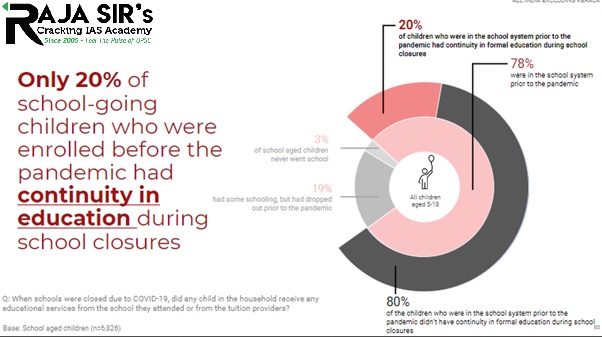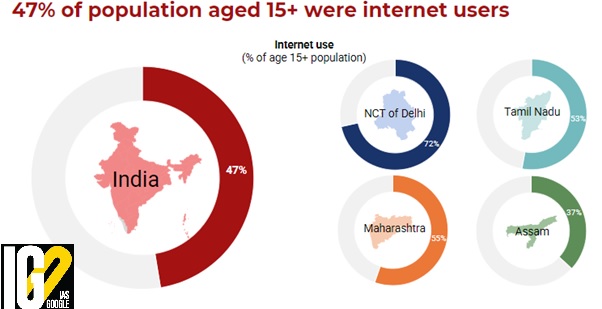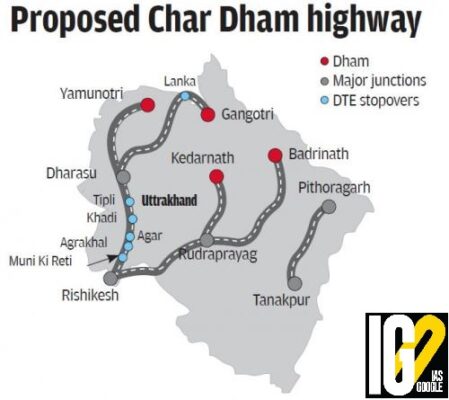- Home
- Prelims
- Mains
- Current Affairs
- Study Materials
- Test Series
15th Nov 2021
REMOTE EDUCATION WAS INACCESSIBLE TO MOST CHILDREN, SAYS SURVEY
Indian Council for Research on International Economic Relations (ICRIER) and LIRNE Asia, unveiled a national sample survey on remote education recently.






 Reasons for air pollution:
Reasons for air pollution:


- The survey was conducted between March and August 2021.

- Only 20% of school age children in India had access to remote education during the pandemic.
- However, only half participated in live online lessons.
- 38% of households reported at least one child had dropped out of school completely due to COVID-19.
- Among children aged 5-18 years, 80% who were enrolled in schools prior to the pandemic did not receive any educational services at all.
- The situation was worse among lower socio-economic classes, and rural households.
- Among the 20% who received education, only 55% had access to live online classes, while 68% had access to recorded audio or video lessons.

- Insufficient number of devices, poor 3G/4G signal and high data cost were the biggest hurdles.
- Of households with school aged children, 64% had internet connections, but only 31% of those received remote education, due to lack of access to devices.
- Those without internet connections the situation was worse, with only 8% receiving remote education.
- Over 13 crore people came online in 2020-21, pushing up the country’s total internet users to more than 47 crores.
- Overall internet usage has spiked from 19% of the population above 15 years in 2017 to 47% this year.
- Only 5% of households had laptops, while 4% had desktop computers.
- The vast majority relied on smartphones, which were available in 68% of households.

- 2018: The government published a circular stipulating maximum road carriageway width of 5.5 metres to minimise the risk of landslides.
- September 2020: The supreme court ordered the Ministry of Road Transport and Highways to follow the 2018 circular on the Char Dham highway project.
- November 2021: Central government asked supreme court to modify the September 2020 order by allowing broadening of the road.
- Rational behind government’s plea:
- The roads in the char Dham project are strategic as it connects the India-China border with the Army camps in Dehradun and Meerut where missile bases are located.
- Thus, widening the road (i.e., carriageway width) will allow Indian military to easily transport missiles across India-China border.
- Protest: An NGO has protested against the widening of roads, citing the felling of trees in the wildlife-rich area.
- The Char Dham project is a two-lane highway project in Uttarakhand, taken up by the Ministry of Road Transport and Highways.
- Aim: To widen the road by 10 meters thereby improving the connectivity between the four important pilgrim towns of Badrinath, Kedarnath, Gangotri and Yamunotri.
- All of these four sites are devoted to a specific deity. Gangotri - Goddess Ganga, Yamunotri
- - Goddess Yamuna, Kedarnath - Lord Shiva and is one of the 12 jyotirlingas, and Badrinath -
- Lord Vishnu.
- It will widen 900 km of highways connecting the pilgrimage sites and the Tanakpur-Pithoragarh stretch of National Highway (NH125), a part of the Kailash Mansarovar Yatra route.
- Implementing Agencies: Uttarakhand State Public Works Department (PWD), Border Roads Organisation (BRO) and the National Highway & Infrastructure Development Corporation Limited (NHIDCL).
- NHIDCL is a fully owned company of the Ministry of Road Transport & Highways.
- BRO, an executive force in India, develops and maintains road networks in India’s border areas and friendly neighbouring countries.
- BRO functions under the Ministry of Defence.
- Border Roads Organisation (BRO) has completed construction of a 440 m long tunnel below the Chamba town on the Rishikesh-Dharasu road highway.
- The construction of the Chamba tunnel is a part of the Char Dham Project.
- The project is being implemented in Engineering, Procurement, and Construction (EPC) model.
- Under the EPC model, the project cost is completely borne by the government.
- Environmentalists had pointed out that the unregulated cutting of trees and scooping up land at the base of the hills is irreversibly damaging the ecosystem
- This resulted in making the regions dangerously prone to landslides.
- The Supreme Court of India appointed a Ravi Chopra committee to look into the matter and it found that several norms were violated during the construction of the project.
- The committee recommended the construction to be done without disturbing the ecological balance.
- Availment of credit without any invoice or any valid document would be blocked by the senior tax officer.
- Availing of credit on invoices by purchasers on which IGST has not been paid by sellers.
- The Input tax credit is availed by the registered person on invoices.
- The officer should consider that the registered person’s input tax credit obtained fraudulently or is ineligible.
- Disallowing such debit is necessary to prevent from utilizing ineligible input tax credit.
- The amount disallowed for debit from electronic credit ledger should not be more than the amount of input tax credit.
- The Commissioner may examine the matter and, if the input tax credit is no longer ineligible then one may allow the use of the credit.

- Principal commissioner or Commissioner will take a decision for blocking of ITC when the monetary amount is above Rs 5 crore.
- Additional commissioner or Joint Commissioner will take a decision when the monetary amount is in the range of Rs 1-5 crore.
- Deputy commissioner or Assistant Commissioner will take decision when the amount is less than Rs 1 crore.
- It refers to the tax already paid by a person at time of purchase of goods or services and which is available as deduction from tax payable.
- The taxes include- the central tax (CGST), State tax (SGST), integrated tax (IGST) or Union territory tax (UTGST).
- A person is in possession of tax invoice or debit note or such other tax paying documents as may be prescribed;
- He has received the goods or services or both;
- The supplier has actually paid the tax charged in respect of the supply to the government;
- He has furnished the return under section 39.
- Due date of return for month of September of next financial year.
- Annual return filed for relevant year.
- Credit of CGST cannot be used for payment of SGST.
- Credit of SGST cannot be utilised for payment of CGST.

- Aim: Enhancing access to government securities market for retail investors in both primary and Secondary market.
- The investors will invest in securities by opening a Retail Direct Gilt (RDG) account with the RBI.
- Registered investors can access the secondary market transaction to buy or sell government securities through NDS-OM (Negotiated Dealing System-Order Matching).
- NDS-OM is a screen based electronic anonymous order matching system for secondary market trading in Government securities owned by RBI.

- It will increase retail participation in government securities and improve ease of access in banking system.
- The ease of investment and safety will develop the wealth of the nation.
- The retail direct scheme allows more retail investor to buy bonds and thus government can borrow more money for developmental works.
- The rising inflation in India adds pressure on the RBI to adopt tighter monetary policy to decrease inflation which is likely to weaken the demand for bonds/securities.
- Less demand for bonds means government can borrow less money from general people and hence the developmental works can’t be fulfilled entirely.
- Aim: Improving the grievance redress mechanism for resolving customer complaints against RBI’s regulated entities.
- It has amalgamated the three existing ombudsman schemes:
- Banking ombudsman Scheme (BOS), 1995,
- Ombudsman for non-banking financial companies (NBFCs), 2018 and
- Ombudsman Scheme for Digital Transactions (OSDT), 2019.
- Customers will be able to file complaints, and give feedback through a single email address.
- The redressal will continue to be cost-free for customers of banks and members of the public.
- The complaints that are not covered under ombudsman scheme will continue to be attended to by the Customer Education and Protection Cells (CEPCs) located in RBI’s 30 regional offices.
- It also includes under its ambit non-scheduled primary co-operative banks with a deposit size of Rs 50 crore and above.
- Minimum investment: 10,000,
- Maximum investment: 2 crores.
- There will be no income tax benefits attached to this investment.
- A common man will not have to run around to lodge his complaints.
- No matter what the nature of the financial grievance, the complainant can lodge it online, and can easily track it.
- It will do away with the jurisdictional limitations as well as limited grounds for complaints.
- It will help in preventing fraud.
- It will improve digital penetration and customer confidence in the banking system.
 Reasons for air pollution:
Reasons for air pollution:
- Vehicular Emission
- Stubble Burning
- Lack of pollution control measures
- Pollutants affect a person’s immunity; it can also cause autoimmune disorders.
- Exposure to pollutants can also lead to a condition called vasculitis, meaning inflammation of blood vessels that leads to narrowing of the vessels. This may cause stroke.
- The polluted air affects some vital organs of the human body.

- Particulate Matter (PM) 2.5 and PM 10 is considered dangerous because these are of respirable size, and can travel down to the lowest part of the lung where gas exchange takes place.
- The particulate matter formed due to diesel or kerosene burning can even cause lung cancer.
- The ultrafine particles of 0.1 micron or less penetrate the lung and reach the blood stream, and once in blood these can reach anywhere — the brain, the heart, kidneys etc.
- Breathing in heavily polluted air can cause irreversible damage to the cardiac arteries.
- The fine particles that lungs aren’t able to filter reach the blood stream, they get attached to the walls of the arteries.
- Over a period, it could lead to the formation of clots and may cause blockage.
- There’s sudden narrowing of the blood vessels that eventually can lead to a heart attack
- Respiratory diseases such as chronic bronchitis can also cause damage to the heart.
- When heart malfunctions, it automatically also affects the brain functioning by restricting the flow of blood or oxygen flow.
- Inhaling pollutants emits certain chemical responses within the body that can also cause stroke over a period of time.
- National Air Quality Index was launched in 2014.
- Aim: To disseminate information on air quality in an easily understandable form for the general public.
- It shows air quality of various pollutants into a single number (index value), nomenclature and colour.
- An AQI between zero and 50 is considered good, 51 and 100 satisfactory, 101 and 200 moderate, 201 and 300 poor, 301 and 400 very poor, and 401 and 500 severe.
- According to Graded Action Response Plan (GARP), the air quality is considered to be in the 'emergency' category if the PM2.5 and PM10 levels continue to be above 300 micrograms per cubic metre and 500 micrograms per cubic metre respectively for 48 hours.
- Eight pollutants act as major parameters in deriving the AQI of an area namely:
- Particulate matter (PM) 10,
- PM 2.5
- Ozone (O3)
- Sulphur dioxide (SO2)
- Nitrogen dioxide (NO2)
- Carbon monoxide (CO)
- Lead (Pb)
- Ammonia (NH3)
- India has launched the National Clean Air Program (NCAP) to reduce PM concentrations by 20-30% by 2024, keeping 2017 as the base year. Under NCAP, 122 non-attainment cities have been identified based on Air Quality data from 2014-2018.
- The Central Government has notified a Comprehensive Action Plan (CAP) in 2018 identifying timelines for actions identified for prevention, control and mitigation of air pollution in Delhi and NCR.
- Graded Response Action Plan (GRAP) was notified on January 12, 2017, for prevention, control and abatement of air pollution in Delhi and NCR.
- It identifies graded measures and implementing agencies for response to four AQI categories, namely, Moderate to Poor, Very Poor, Severe and Severe + or Emergency.
- SAMEER app has been launched wherein air quality information is available to public along with provision for registering complaints against air polluting activities.
- Crowd sourcing of innovative ideas/ suggestions/proposals from public is done through Central Pollution Control Board website to strengthen efforts for improving air quality in Delhi-NCR.
- A smog tower at has been installed in Delhi with a height of over 20m, is of downdraft type, i.e., polluted air comes in from the top of the tower and clean air comes out of the bottom is intended for localised reduction in air pollution (Particulate Matter).
- PRAN portal:
- The PRANA portal will provide all information related to various policies/programmes/schemes/activities of the stakeholders along with the progress made towards improvement in air quality across the country.
- This portal will be a platform for monitoring and feedback on all efforts made for air quality improvement.
- In the conference, it was discussed that Infestation of desert locusts, which has plagued a vast swathe from eastern Africa to India in recent years, is closely linked to climate change.

- They are a group of short-horned grasshoppers that often increase greatly in numbers and migrate long distances.
- Locusts are termed as the oldest migratory pests in the world.
- They are large herbivorous insects.
- It can be serious pests of agriculture due to their ability to form dense and highly mobile swarms.
- They differ from ordinary grasshoppers in their ability to change behaviour (gregarize) and form swarms that can migrate over large distance.
- Adult male and female locusts are distinguished by the shape of the tip of the abdomen.
- Male - tip of abdomen smooth and rounded.
- Female - tip of abdomen jagged
- Adult male locusts are smaller than adult females of the same species.
- Desert locust
- Migratory locust
- Bombay Locust
- Tree locust
- On Farmers: Locusts not only destroy valuable standing crops but can also devastate the livelihoods of farmers and those associated with the agricultural supply chain.
- On Urban Areas: Due to harvest of Rabi crops, there were no crops in the field. This led to the desert locusts invade green spaces in urban areas.
- An integrated climate change mitigation, disaster management, and sustainable development system needs to be developed in order to deal with the locust attack.
- Aerial spraying of the optimum number of insecticides at all possible breeding sites.
- Continuous crop monitoring during the subsequent Kharif season is required.
- The Indian Council of Agricultural Research (ICAR) has admitted that since the 1990s there has not been much" systematic research "on desert locusts and the current invasion is a wake-up call to revive the program.
- To allocate more funds to forecast current global environmental changes in order to understand the causes, implications, and formulate national responses.
- There is also a need to strengthen the disaster management framework at the local level.
- It works under Ministry of Agriculture.
- Headquarters: Jodhpur, Rajasthan.
- Key responsibility: Monitoring and control of the locust situation in Scheduled Desert Areas mainly in Rajasthan and Gujarat, and partly in Punjab and Haryana.
- It implements the Locust Control and Research scheme.









 Latest News
Latest News
 General Studies
General Studies